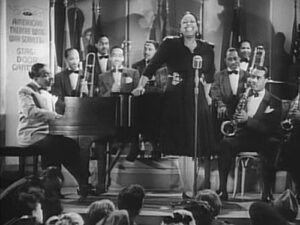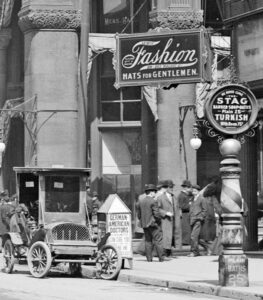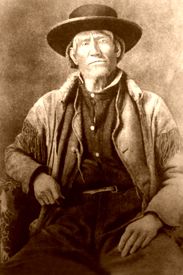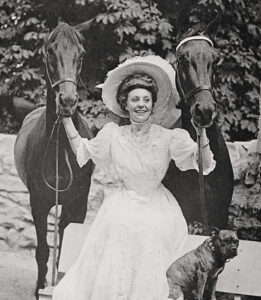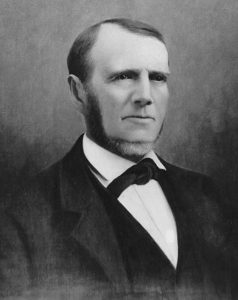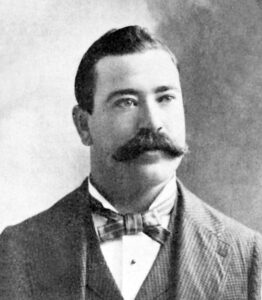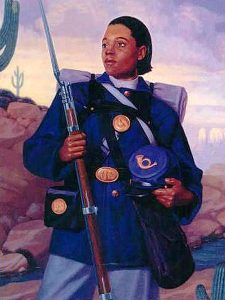Every city and every place leaves behind numerous people that made it what it is today. Here are a few that shaped Kansas City, Missouri.
Count Basie (1904-1984) – Basie was an American jazz pianist, organist, bandleader, and composer. He a leading figure in jazz’s swing era that took place during the late 1920s and early 1930s. Before he climbed to international fame, Basie was discovered in Kansas City. In 1935, he formed the Count Basie Orchestra. His legacy lies in the 18th & Vine Historic Jazz District of Kansas City.
Thomas Hart Benton (1889-1975) – An American painter, muralist, and printmaker, Benton was born in Neosho, Missouri but spent much of his later life in Kansas City. The Thomas Hart Benton’s Victorian Home and Studio State Historic Site remain just as he left it, with coffee cans full of paintbrushes and stretched canvases featuring several of Benton’s paintings and sculptures.
George Caleb Bingham (1811-1879) – An artist, soldier, and politician, he was known in his lifetime as “the Missouri Artist.” He was elected as a delegate to the Missouri legislature before the Civil War, where he fought against extending slavery westward.
Annie Ridenbaugh Bird (1856-1937) – Annie served as Emery, Bird, Thayer & Company president from 1920 to 1937. Her husband, Joseph T. Bird, was one of the owners of the large department store. She was always knowledgeable about her husband’s work and was named president of the company after his death. She was the first woman in Kansas City to assume such a prominent role in a large commercial enterprise, and she successfully navigated this responsibility until she died in 1937.
Lucile Harris Bluford (1911-2003) – A journalist, civil rights crusader, and a woman of many achievements, she is best known for her 70-year career at The Kansas City Call newspaper. At The Call, she worked her way up from reporter to editor, owner, and publisher.
Albert G. Boone (1806-1884) – Albert Gallatin Boone, the grandson of Daniel Boone, was a trapper, trader, businessman, and Indian Agent of the American West. In 1854, he bought the Ewing building in Westport, a supply store for pioneers, trappers, and traders traveling through Westport along the Santa Fe Trail and other routes. One of the oldest brick commercial buildings in present-day Kansas City, it became a tavern called Kelly’s Westport Inn in 1947 and still serves customers today.
Jim Bridger (1804-1904) – Often called “The King of The Mountain Men,” he joined William Ashley’s first trapping expedition to the upper Missouri River in 1822. Bridger was 49 years old when he first became involved in Westport. In 1866, he purchased Chouteau’s Store at 504 Westport Road, one of the oldest buildings still in Westport.
Esther Swirk Brown (1917-1970) – A civil rights activist, she is best known for leading efforts in the landmark desegregation cases Webb v. Kansas and Brown v. Board of Education of Topeka, Kansas. A Kansas City native, she later moved to Merriam, Kansas, where she discovered the appalling conditions of the local black school. She launched a crusade to fight injustice and racial inequality culminating in the Brown v. Board decision to mandate the desegregation of schools.
William M. Chick (1794-1847) – A Kansas City, Missouri pioneer, founder, merchant, and first postmaster.
Colonel Kersey Coates (1823-1887) – A Kansas City businessman who developed Quality Hill, founded the Kansas City Board of Trade and was among those who attracted the Hannibal & St. Joseph Railroad to the city.
Sarah Chandler Coates (1829-1897) – A suffragette, abolitionist, and progressive social leader, she was known as the “Queen of Quality Hill.” Along with her husband, Kersey Coates, they worked together to develop and enrich the city.
Loula Long Combs (1881-1971) – A renowned equestrian and horse trainer, she was the daughter of Robert A. Long. She began breeding and training horses at the Long Mansion and Longview Farm. After her first horse show in 1896 at Fairmount Park, Loula went on to show horses for nearly 65 years, winning many awards at the American Royal and elsewhere.
Eliza “Lyda” Burton Conley (c1869-1946) – A member of the Wyandot Nation, she is thought to be the first female lawyer of Indian descent in the United States. SLyda graduated from the Kansas City School of Law in 1902 and was admitted to the Missouri and Kansas bar associations.
Walt Disney (1901-1966) – After attending the Kansas City Art Institute, Disney opened Laugh-O-Gram Studio, his first, on the corner of 31st Street and Forest Avenue in Kansas City. Disney fed a friendly rodent in the building, which was said to have inspired the character Mickey Mouse. Fans can visit his childhood home and farm 125 miles east of Kansas City in Marceline, Missouri.
Andrew “Rube” Foster (1879-1930) – An astute businessman and visionary, Foster founded the Negro National League in 1920. He set his sights on eventually integrating the teams, not just its players, into baseball’s National and American Leagues. His co-creator in this league which thrived for nearly 40 years, was J.L. “Wilkie” Wilkerson, an accomplished pitcher who, although white, became a significant influence and one of the most respected personalities in black baseball history.
Robert Gillham (1854-1899) – Robert Gillham founded Kansas City, Missouri’s Cable Railway System. He was one of the pioneers in cable railway construction, and when he entered this field, there were only three cable railways in the country, all in San Francisco, California.
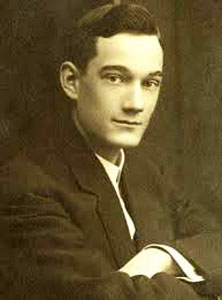
Joyce C. Hall
Joyce C. Hall (1891-1992) – The founder of Hallmark Cards came to Kansas City in 1910 with only two shoe boxes full of postcards. This marked the beginning of one of the world’s largest greeting card companies. Hallmark’s world headquarters is in downtown Kansas City.
John Harris (1795-1874) – A pioneer, farmer, and proprietor of Westport’s first hotel. In 1855, John and Henrietta Harris built a Southern colonial-style mansion “on a ridge just east of town.” The Harris-Kearney House remains a museum at 4000 Baltimore Avenue in Kansas City.
Alexander Franklin “Frank” James, aka: “Buck,” Frank Vaughn (1843-1915) – An outlaw and brother of Jesse James, he rode with the James-Younger Gang and the James Gang. He surrendered to Governor T.T. Crittenden after Jesse was killed. He was acquitted of murder and robbery, lived peacefully in Kearny, Missouri, and died on February 19, 1915.
Jesse Woodson James (1847-1882) – The famous outlaw and leader of the James-Younger Gang and James Gang after the Youngers were arrested. He robbed banks and trains for sixteen years. He was shot in the back of the head by Robert Ford in his home in St. Joseph, Missouri, on April 3, 1881.
William Thornton Kemper Sr. (1867-1938) – Kemper was a banker and the patriarch of the Missouri Kemper family, which developed both Commerce Bancshares and United Missouri Bank to become a significant banking family in the Midwest.
George E. Kessler (1862-1923) – After opening an office in Kansas City, a city planner and landscape architect was commissioned to work in Kansas City’s fashionable Hyde Park neighborhood in 1887. The project’s success drew the attention of The Kansas City Star publisher, William Rockhill Nelson, who would champion the City Beautiful Movement.
Robert A. Long (1850-1934) – Long was a lumber baron, developer, investor, newspaper owner, and philanthropist. He lived most of his life in Kansas City, Missouri, and established Longview Farm, now listed on the National Register of Historic Places.
Alexander Majors (1814-1900) – From Kentucky, Majors was a businessman who began hauling overland freight on the Santa Fe Trail in 1848. He became the managing partner of Russell, Majors, and Waddell in 1854, with offices in Westport. The firm founded the Pony Express and Central Overland California and Pikes Peak Express Company. The wagon trains moved enormous tonnage of the western trails to U.S. forts. At one point, the firm employed 4,000 men and had 3,000 wagons, 40,000 oxen, and 1,000 mules. His home and freighting office, built in 1856, a historic landmark and museum today, still stands at 8201 State Line Road.
John C. McCoy (1811-1889) – Known as the father of Westport and Kansas City, the surveyor and planner of Leavenworth, Kansas, he built a two-story log building on the northeast corner of Westport Road and Pennsylvania in 1833.
J. C. Nichols (1880-1950) – Jesse Clyde “J. C.” Nichols was an American commercial and residential real estate developer in Kansas City, Missouri.
Buck O’Neil (1911-2006) – This baseball star spent most of his life in Kansas City, where he played and managed for the Kansas City Monarchs of the Negro American League. Buck is credited as the first African-American coach in Major League Baseball and played an integral role in establishing the Negro Leagues Baseball Museum.
Hiram Milton Northrup (1818-1893) – Hiram Northrup was a trader, businessman, and banker in Kansas City, Missouri, and Wyandotte, Kansas.
Satchel Paige (1906–1982) – This legendary Negro Leagues pitcher played for the Kansas City Monarchs and pitched in two Negro World Series and five East-West All-Star games.
Charlie Parker (1920-1955) – A Kansas City native, Parker was a jazz saxophonist, band leader, and composer. He took the jazz world by storm in the 1940s. The “The Bird Lives” Charlie Parker Memorial is at the 18th & Vine Historic Jazz District.
James F. Pendergast (1856-1911) – A Democratic politician and the first Big City Boss of Kansas City, Missouri. He was the elder brother of Thomas J. Pendergast.
Thomas J. Pendergast (1872-1945) – Also known as T. J. Pendergast, was a political boss who controlled Kansas City and Jackson County, Missouri, from 1925 to 1939.
Henry Perry (1874-1940) – An American chef and restaurateur, he was the self-proclaimed “Father of Kansas City barbecue.”
Nelle Nichols Peters (1884-1974) – An architect who designed nearly 1,000 buildings in Kansas City, including apartments, hotels, houses, churches, and factories. She was among the few female architects in the United States when she started her practice in 1909. Many of the buildings she designed were nominated for historic designation, including the Ambassador Hotel, the Country Club Plaza Poets District apartments, and the McConahay Building, where Walt Disney’s Laugh-O-Gram Films was once located.
Nell Donnelly Reed (1889-1991) – A women’s clothing designer and entrepreneur, she founded the multimillion-dollar Donnelly Garment Company. After moving to Kansas City in 1906, she noticed a lack of stylish and affordable dresses and began sewing her own. By 1931, her business had grown to 1,000 employees and was worth $3.5 million. She survived the Great Depression and thrived until Nell’s retirement in 1956.
Nathan Scarritt (1821-1890) – A prominent Methodist missionary, preacher, teacher, and real estate developer, he became a teacher at the Shawnee Methodist Mission in Kansas in 1848. He then moved to Westport. Later he established Melrose Methodist Church, established the Scarritt Bible and Training School, and developed Scarritt Point. When he died in 1890, his estate was valued at more than three million dollars.
Joe Shannon (1867-1943) – A Democratic political boss in Kansas City, rivaling the more dominant James Pendergast political machine in the late 19th and early 20th centuries.
Harry S. Truman (1884-1972) – The 33rd president of the United States, serving from 1945 to 1953, this Independence, Missouri native first served as vice president under Franklin Roosevelt and as a United States senator from Missouri from 1935 to January 1945.
Fats Waller (1904-1943) – Thomas Wright “Fats” Waller was an American jazz pianist, organist, composer, violinist, singer, and comedic entertainer. His innovations in the Harlem Stride style laid much of the basis for modern jazz piano.
Carrie Westlake Whitney (1854-1934) – A librarian, she was known as the mother of Kansas City. She was the first director of the Kansas City Public Library.
Cathay Williams (1842-c1893) – When Congress passed an act that established the first all-Black military units in 1866, later known as Buffalo Soldiers. Cathay Williams, a former slave from Independence, Missouri, joined the Army, posing as a man and calling herself William Cathay.
John B. Wornall (1822-1892) – Wornall moved to Westport, Missouri, with his parents in 1843. They purchased 500 acres from town founder John Calvin McCoy in the area of present-day 63rd and Wornall Road and farmed. John built an elegant home at 6115 Wornall Road in 1858. It still stands as a museum at 6115 Wornall Road in Kansas City.
Josephine Silone Yates (c1859-1912) – Yates was a renowned teacher, writer, and outspoken advocate for racial equality. A native of New York, she married and moved to Kansas City. In 1893, she co-founded the Kansas City Women’s League, which eventually merged with the National Association of Colored Women.
Hiram Young (1812-1882) – An African-American entrepreneur, Young was one of the leading manufacturers of wagons in Independence, Missouri, for westward pioneers in the mid-19th century.
Younger Brothers – The infamous Younger Brothers of Jackson County, Missouri, sons of a prosperous slave-owning farmer, would grow up to become some of the most well-known Civil War guerrillas and outlaws in history when they joined up with Frank and Jesse James to form the James-Younger Gang.
©Kathy Alexander/Legends of America, updated March 2024.
Also See:
Sources:
Kansas City History
Visit Kansas City
Visit Kansas City – 2
Westport Historical


